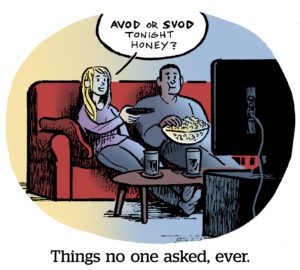Viewers are switching up how they watch their favorite shows.
2021 was a record year for CTV.
Now, at least one CTV device can be found in over 80% of American homes, and CTV ad budgets are expected to double by 2026, according to GroupM’s most recent industry forecast.
But the key to unlocking those ad dollars lies in being able to unite audience-based buying with the sort of high-quality, engaging content that linear TV has traditionally been known for.
AdExchanger spoke with industry experts across the buy and sell side about what they see on the horizon for CTV in 2022.
In short, expect a focus on identity, more interactivity, the continued rise of ad-supported video on demand (AVOD) and the ongoing convergence of TV and online video.
“From demography to identity”
Identifying and measuring audiences across screens with precision is becoming more challenging with the rise of new platforms and services.
Nielsen’s recent woes are evidence that the industry is looking for new, more effective measurement methods. Nielsen, the long-time standard for TV ratings, lost its Media Rating Council accreditation in September after its panel-based approach proved insufficient during the early days of the pandemic.
As a result, broadcasters and media buyers are starting to experiment with alternative currencies to measure deduplicated audiences across linear and CTV platforms.
But the tables were already starting to turn before Nielsen’s stumble, said Tal Chalozin, CTO and co-founder of video ad server Innovid.
“The world of identity has been in flux,” Chalozin said.
Case in point, see IP addresses, which Chalozin called “the last non-consent-based identifier left.” IP addresses are used heavily in CTV. With privacy regulations on the rise, there could be a reckoning coming for IP addresses in 2022, he noted.
In the meantime, industry players and data providers will need to continue trialing new ways to make the most of the audience data they have.
“We’re going to see a lot more clean room technology,” Chalozin predicted. Clean rooms are privacy-safe spaces for media companies and advertisers to share their first-party data for targeting and measurement purposes.
The rise of clean room tech will help TV advertisers move beyond basic age and gender and do more advanced addressable audience-based buying.
“2021 was when the toggle really shifted and audience-based buying crystallized,” said Sean Cunningham, president and CEO at the Video Advertising Bureau.
“We’re continuing the migration from demography to identity – and the real determiner of success will be the commitment to data precision.”
But there’s another big shift coming to the TV – and that’s the rise of interactive content.
“We’re in a golden age of content,” said Diana Horowitz, SVP of advertising sales at sports-first streaming platform fuboTV. “[And] viewers are truly agnostic to where they’re viewing content.”
In other words, engaging, high-quality content will be key to attracting committed viewers, and CTV provides an opportunity to breathe new life into interactive programming.
Remember dialing in your votes to early-2000s American Idol? The same concept is applicable via streaming, but with a twist. FuboTV, for example, rolled out a free-to-play platform over the summer that gives viewers a chance to win prizes as a reward for predicting the outcome of sporting events.
“It goes back in part to the earlier days of television, when people watched the same things at the same time,” Horowitz said. “There’s always going to be a place for what we call live television. … But that’s just the tip of the iceberg.”
Interactive programming that can encourage viewers to take action is a promising indicator that they’ll also respond to ecommerce advertising when watching TV content.
“The ability to purchase what you see on the screen will accelerate,” Horowitz predicted. “That premium, big-screen viewing experience is a big reason why we see [an] acceptance of advertising.”
New forms of audience engagement – and the ability to drive real-world purchases – means advertisers will need to measure more than impressions.
“Just watching TV isn’t enough – it depends on what you’re watching, and how engaged you are with the program,” said Kevin Krim, president and CEO of EDO, an analytics provider focused on engagement outcomes. “That’ll determine how engaged you are with the ad break and the messages in the ad break.”
TV (and, by extension, CTV) are good channels for ecommerce marketers because they drive action across the funnel, Krim added.
When people see an ad on TV for something they want, the first thing they often do is immediately search for it online.
Ads are here to stay
Of course, not all premium video content has ads.
But 2021 tipped the scales of preference between subscription-based and ad-supported content.
Subscription-based streaming services attracted millions of subscribers quickly, a trend that greatly accelerated during the 2020 pandemic. “Early adopters are a little more affluent, and it’s easier for them to jump into the paid solution,” Chalozin said.
As streaming matures, however, and the mass market comes onboard, “you see different behavior,” he said, and “you need more low-cost, subsidized solutions – or you have competition, and it’s impossible for people to pay for all of them.”
The numbers agree that subscription streaming is coming back down to earth. In December 2021, TVision reported that the total viewership share of AVOD platforms increased by 9.3% between Q1 and Q3 of 2021 alone. Meanwhile, subscription-based platform viewership dropped 8.6% during the same period.
“In 2016, I said AVOD will be akin to basic cable in the nineties within five years,” said Andre Swanston, SVP of the media and entertainment vertical at TransUnion. “And now these AVOD services are reaching 80 million homes.”
“The growth of free AVOD services is also not slowing down anytime soon,” Swanston added, especially as “more original content is coming to those platforms – that’s where the ballgame is.”
It’s a virtuous cycle: More content means more eyeballs, and more eyeballs means more ad dollars.
“2022 is when we’ll start to see big shifts by new entrances into the market,” Chalozin said. “Tens of thousands of marketers will be able to access television … and [they will be able to do] much better, with more personalized targeting.”
Beggars can (and should) be choosers
This doesn’t mean SVOD will eventually become a thing of the past. Rather, streaming platforms will need to invest in and expand their content offerings to keep up with the new normal – endless consumer choice.
We’re going to see more hybrid models emerge with subscription services that have ad-supported tiers, Chalozin said.
HBO, for instance, was originally opposed to ads, but later introduced an ad-supported tier for HBO Max. ViacomCBS-owned streamer BET+ is also rolling out an ad-supported tier in 2022.
“Consumers want choice, they want personalization and they want it at a fair economic exchange,” Cunningham said.
End game: Convergence
There’s one more thing consumers want, however, and that’s to lean back.
“They’re gravitating toward that traditional, big screen premium experience,” said Tess O’Brien, VP of demand software sales at Comcast-owned FreeWheel.
But what does convergence look like behind the scenes?
Advertisers are turning to CTV to drive incremental reach for their linear campaigns.
Incremental reach is the deduplicated audience across an advertiser’s linear and CTV ad buys.
“It’s who you couldn’t reach with your linear TV schedule that you’re now reaching through your additional CTV buy,” O’Brien said.
It’s possible to achieve this incrementality because consumers crave choice.
“Consumers are always going to want all the options that are available to them,” O’Brien said.
This article has been updated.















